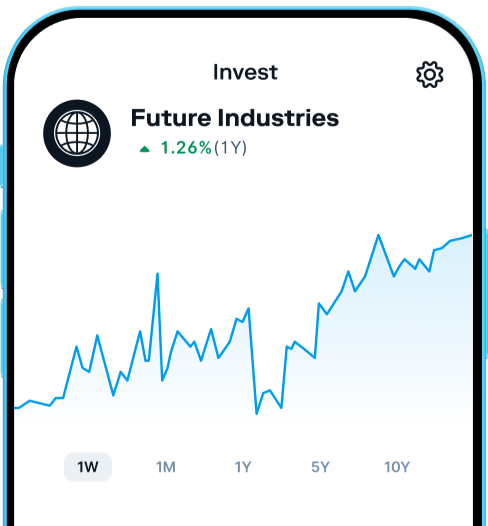How to invest The Stash Way®.
New to investing? Beginner or pro, our investing philosophy can help guide you.
Get startedTo begin investing on Stash, you must be approved from an account verification perspective and open a brokerage account.


Do it with Stash.
Recurring investing
Just tell us how much and how often to invest for you.
Stock-Back® Card
Earn pieces of stock as you spend and live your everyday life.1
See the potential of compounding.
Based on an estimated 8% average growth rate per year.
/ week
5 years
10 years
20 years
Hypothetical projection: All investments involve risk, including loss of principal. This projection illustrates hypothetically, how factors such as recurring investments (amount and frequency) may impact the long-term value of investing given an 8% hypothetical rate of return (compounded annually). Please note, your account may be different for many reasons including, but not limited to, market fluctuations and volatility, changes in your recurring investments, withdrawals and additional investments, time horizon, taxes and fees, including your Subscription fees. This projection does not represent the actual performance of any client nor does it reflect the performance of any of the underlying investments therein. Diversification, asset allocation, and dollar cost averaging does not ensure a profit or guarantee against loss. Your actual investment return and principal value may fluctuate, so you may realize a gain or loss when shares are redeemed or sold. Please consider your objectives before investing. Investment outcomes and projections are forward-looking statements and hypothetical in nature. Your account balance may be more or less than your original investment. This example is for illustrative purposes only and is not indicative of the performance of any actual investment.
Hypothetical values shown in this tool assume the following factors: 1.) weekly contributions 2.) a 20 year time horizon 3.) No other account account deposits, investments, fees, or dividend reinvestment 4.) No withdrawals taken from this account. This tool does not take your existing account balance into consideration.
Do it with Stash.
Children’s investment accounts
Invest for the whole family with children’s custodial accounts.5
Retirement accounts
Plan for a secure retirement with an IRA from Stash.4
Advice by Stash
We can guide you as you build wealth for the long-term.
S&P 500 performance over time

Disclosure: This is not a prediction or projection of performance of an investment or investment strategy. Past performance is no guarantee of future results. Any historical returns, expected returns or probability projections are hypothetical in nature and may not reflect actual future performance. The rate of return on investments can vary widely over time, especially for long term investments including the potential loss of principal. For example, the S&P 500® for the 10 years ending 1/1/2014, had an annual compounded rate of return of 8.06%, including reinvestment of dividends (source: www.standardandpoors.com). Since 1970, the highest 12-month return was 61% (June 1982 through June 1983). The lowest 12-month return was -43% (March 2008 to March 2009). The S&P 500® is an index of 500 stocks seen as a leading indicator of U.S. equities and a reflection of the performance of the large cap universe, made up of companies selected by economists. The S&P 500 is a market value weighted index and one of the common benchmarks for the U.S. stock market.
Do it with Stash.
Diversification analysis
We’ll analyze your portfolio and recommend investments.
Fractional shares
Start investing with whatever amount you can afford—like $5.
Stash through the “Diversification Analysis” feature does not rebalance portfolios or otherwise manage the Personal Portfolio Account for Clients on a discretionary basis. Each Client is solely responsible for implementing any such advice. This investment recommendation relies entirely on the responses you’ve provided regarding your risk tolerance. Stash does not verify the completeness or accuracy of such information. Investing involves risk, including possible loss of principal. No asset allocation is a guarantee against loss of principal.
By using this website you agree to our Terms of Use and Privacy Policy.To begin investing on Stash, you must be approved from an account verification perspective and open a brokerage account.
There is no guarantee that any investment strategy will work under all market conditions or is suitable for all investors. Each investor should evaluate their ability to invest long-term, especially during periods of downturn in the market. Before investing, please carefully consider your willingness to take on risk and your financial ability to afford investment losses when deciding how much individual security exposure to have in your investment portfolio.


